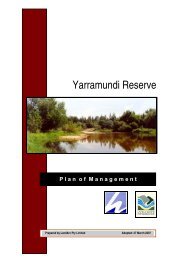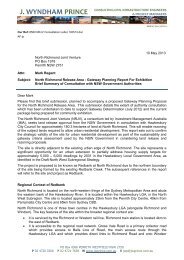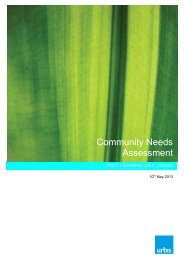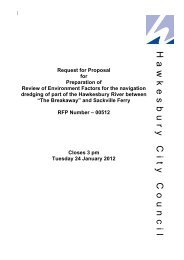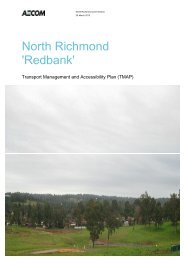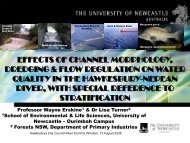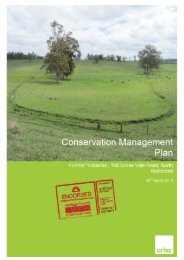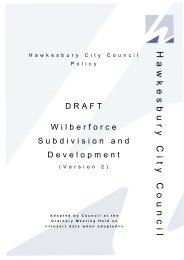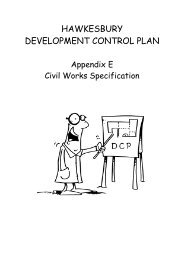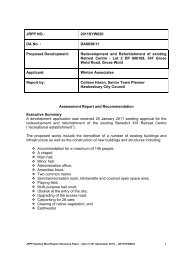Attachment 1 to Item 53 - Roadside Vegetation Management Plan
Attachment 1 to Item 53 - Roadside Vegetation Management Plan
Attachment 1 to Item 53 - Roadside Vegetation Management Plan
Create successful ePaper yourself
Turn your PDF publications into a flip-book with our unique Google optimized e-Paper software.
H AW K E S B U R Y C IT Y C O U N C IL R O AD S ID E V E G E T AT IO N M AN AG E M E N T P L AN<br />
• The width of the road envelope will be the width of the road (minimum 6.2 m width) plus a 2<br />
m shoulder on either side of the road (Austroads 2009), this provides for two lanes each<br />
being 3.1 m wide and the shoulder being 1.5 m wide (Figure 4);<br />
• <strong>Vegetation</strong> outside of these clearance distances (heights and widths) should not be cleared<br />
or disturbed, unless a full assessment of their impacts are performed and approval given.<br />
6.2 ROAD CONSTRUCTION OR WIDENING<br />
Road construction and widening works can have substantial impacts on roadside vegetation, depending<br />
on the scale of works (see Section 3.1). The following actions should be taken when constructing<br />
roads.<br />
• Prior <strong>to</strong> preparation of plans for road construction or widening, investigate the relevant<br />
permit requirements (e.g. is work occurring near a waterbody).<br />
• Carry out site inspections with all interested parties prior <strong>to</strong> the preparation of road<br />
construction or widening plans on roads of high and medium conservation value. This will<br />
ensure that the most appropriate methods <strong>to</strong> minimise vegetation loss will be included and<br />
will assist <strong>to</strong> plan the rehabilitation of the site after works are completed.<br />
• Conduct an assessment <strong>to</strong> determine impacts on environmental and other values (REF or<br />
EIS) prior <strong>to</strong> road construction or widening works being carried out. The environmental<br />
assessment should involve Council staff from design, planning and works walking the<br />
entire route <strong>to</strong> identify significant roadside vegetation and other environmental<br />
considerations. The process should, among other things, identify:<br />
o all construction activities and where they will take place, including s<strong>to</strong>ckpiles and<br />
dump sites, site sheds, machinery s<strong>to</strong>rage and turn around points, vehicle parking<br />
sites, access roads;<br />
o sites of environmental or cultural significance that are not <strong>to</strong> be disturbed; and<br />
o the location and type of erosion and sediment control measures.<br />
• Consider modifying the design <strong>to</strong> reduce vegetation loss (e.g. different alignments,<br />
pavement and shoulder widths, use of kerb and channel);<br />
• <strong>Plan</strong> the construction phase <strong>to</strong> occur at the optimum time of year <strong>to</strong> minimise impacts (e.g.<br />
erosion). To minimise erosion, undertake (where appropriate) construction works in stages<br />
so as <strong>to</strong> expose the smallest work area for the shortest time;<br />
• Prior <strong>to</strong> commencement of works:<br />
o identify all boundaries and use fencing, barricades or other markers <strong>to</strong> delineate<br />
these;<br />
o inform all workers and contrac<strong>to</strong>rs of permit conditions; and<br />
o train workers and contrac<strong>to</strong>rs in erosion control, vegetation removal and vegetation<br />
protection measures prior <strong>to</strong> commencement of works.<br />
• Apply general principles during road construction that will assist in protecting roadside<br />
vegetation:<br />
o Stay within limits of construction (disturbance) zones;<br />
o avoid using or s<strong>to</strong>ring heavy machinery on all native roadside vegetation where<br />
possible;<br />
o keep construction machinery out of high and medium priority roadside vegetation<br />
sites;<br />
o keep machinery, equipment or material on designated s<strong>to</strong>rage places clear of native<br />
trees, shrubs and grasses, and use designated turning circles. Use of areas<br />
supporting native vegetation by machinery, equipment or material can damage the<br />
groundcover vegetation and cause soil compaction, which damages tree roots;<br />
© E C O L O G I C AL AU S T R AL I A P T Y L T D<br />
48



